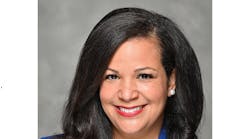Sipping a latte, sending a batch of instant messages, stopping to pick up cash, scheduling a weekend trek, and later settling in for an evening of music with friends — all within walking distance.
A vacation resort? A pedestrian village? Perhaps, but just as likely these activities and many more take place on many university campuses, designed and renovated dramatically to be more student-centered than they were 50 or even 20 years ago.
At the heart of this change is a new approach to the student union building. The student union is a highlight when new recruits, families and parents first visit a campus. The union has become an attractive tool for recruiting and retention — for students, faculty and staff.
“Rapid response”
Universities spend significant amounts of money to provide kitchen and serving facilities in student unions. They are designing “rapid response” food-service areas that can be remodeled quickly and inexpensively to adapt to changing student preferences.
Food service at student unions is a good example of student preference changes. Many students are not interested in dining in huge cafeteria spaces and are drawn to smaller, varied, restaurant-style spaces with a more appealing ambience. These spaces can be used outside peak dining hours with designs that allow the areas to function as lounges or meeting areas. Acoustics, space planning, finishes and fixtures can give flexibility to a dining space.
Different food-service concepts and venues require different equipment. Schools should be able to modify food-service components easily. Plug-in components can be changed more easily than built-ins. Clustering four to five different restaurant venues around or above a large, central production kitchen also can help diversify and reduce equipment costs for food service. Smaller serving kitchens, supported by a central kitchen, can be placed adjacent to these different venues, and provide varied food and beverage service.
Retail operations
Difficult economic times are whittling away student union operating funds. Devoting student union square footage to stores and kiosks for retail operations, especially those that create a student-centered experience, enables universities to maximize those funds. Generating business from students is critical to the success of any union retail operation. Operations that create a student-centered experience will be more successful, will have higher revenues, and will be better able to meet their lease and contribution obligations.
Automatic teller machines (ATMs) are popular among students. Other businesses with potential for success are travel agencies, dry cleaners, bike shops, hair salons and barber shops, photo and copy centers, bookstores, convenience or mini-grocery stores (especially with late-night hours), postal offices, ticket-sales counters, coffeehouses, snack bars, outdoor recreation outlets (for organizing tours, mountain climbing, treks, rock climbing and renting equipment), video stores, and floral and gift shops.
Satellite union buildings
Many student unions face competition from “academic villages” created when academic colleges and departments add on-site lounges within their buildings. Because this dilutes the purpose of the main union, some universities may seek to make the academic villages part of the union's primary operation.
These entities within academic college buildings provide food service, study lounges, small libraries or resource centers, and technology areas with wireless Internet access. Instead of walking across campus to the student union for similar services, students find it easier to hang out at their own department's lounges.
In response, some universities are encouraging satellite student unions. Satellite student unions seek to provide something distinct from academic villages: a place where students can come and relax, be with a diverse group of friends, participate in campuswide programs, and take a break from academic studies.
Creative multipurpose space
The trend toward multipurpose space in student unions reverses the tendency toward compartmentalized dining, single-use conference rooms and isolated spaces for student organizations. Now, universities are designing spaces to allow for all of these activities. One school, noting that union usage dropped off after 3 p.m., designed a lounge to double as a nightclub.
The programs and services offered by the student union are changing so fast that some universities are using interactive polling to determine student preferences and the right design mix. To keep current, universities may make changes at least every five years. For student unions with several different food venues, one might be changed fully every year.
In planning spaces for these changing preferences, flexibility allows more opportunity to alter spaces without rebuilding. And when a space is designed for two to three different functions, less square footage is necessary.
Creative planning will give a student union different personalities throughout the day: from morning, with students zooming through for coffee; to lunch, when students hang out to see friends; to night, when hosting dinner meetings for clubs and student government. Late-night usage is important, too.
One-stop shopping
Student unions are starting to provide “one-stop shopping,” including aspects of campus life that traditionally haven't gone into unions: academic advising, registrar, bursar's office and similar services that students typically must walk all over campus to receive.
These essential student services, such as registrar, financial aid, scholarship, registration and student ID cards, often have been in separate buildings in order to house all of the necessary staff and records. For students, it is inconvenient to go to different buildings; student unions can accommodate a one-stop shop within a small percentage of the total square footage, where students can take care of these needs. Similar to customer-service centers, they are staffed by a few employees with computer terminals that link to central campus services.
Emerging trends in student union design can have significant impact on their appeal and financial success. Unions don't need to spend a lot of money to be up-to-date; they need only to use creativity in responding to student needs on an ongoing basis.
Taft, AIA, LEED AP, a vice president with MHTN Architects, Salt Lake City, Utah, leads the firm's higher education design studio. MHTN specializes in student union facility design and has completed more than 20 student union projects.

